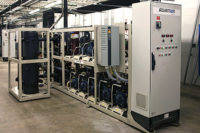It still could find its way to North America in some applications. The most recent "Refrigerant Report" (12th edition) from Bitzer International offers a detailed look at R-290 from the perspective of contractors and technicians.

R-290 As A Substitute For R-502 And -22
According to the report, "R-290 can be used as a substitute refrigerant. As it is an organic compound (hydrocarbon), it does not have an ozone depletion potential and [it has] a negligible direct global warming effect." But there is a consideration when it comes to summer smog, according to the report.It was noted that propane's pressure levels and the refrigeration capacity are similar to R-22 and -502, and its temperature behavior is as favorable as R-12 and -502.
There are no particular material problems. In contrast to NH3 (ammonia), copper materials are also suitable. And, R-290 can be used with semi-hermetic and hermetic compressors.
"The mineral oils usually found in a CFC system can be used here as a lubricant over a wide application range," the report states.
"Refrigeration plants with R-290 have been in operation world-wide for many years, mainly in the industrial area.
"It is a proven refrigerant."
Applications for the refrigerant can also extend to smaller systems. "R-290 can be used in smaller, compact systems with low refrigerant charges, like residential A/C units and heat pumps," the report states. "Furthermore, a rising trend can be seen in its use with commercial refrigeration systems and chillers."
It can also be offered mixed with R-600a (isobutene) or R-170 (ethane). "This should obtain a good performance match with halocarbon refrigerants."
Disadvantages
The flammability issue was analyzed in the report. The refrigerant is classified as A3. "With the normal refrigerant charge found in commercial plants, this means that the system must be designed according to ‘flame-proof' regulations."Here are a few more considerations outlined in the report:
"In addition, measures are required to ensure hazard-free ventilation to effectively prevent a flammable gas mixture occurring in case of refrigerant leakage."
Advantages
The report looks primarily at the positive aspects of R-290."Apart from measures previously mentioned, propane plants require practically no special features in the medium- to low-temperature ranges. When sizing components, consideration should, however, be given to the relatively low mass flow (approximately 55 to 60 percent compared to R-22). An advantage in connection with this is the possibility of a greatly reduced refrigerant charge."
The study goes into detail about the types of components needed in such a system, including:
A Final Consideration
The report does suggest that a propane-based refrigerant system be designed as a new installation, not as a retrofit."Due to the flame-proof protection measures required for an R-290 plant, it would appear that a conversion of an existing plant is only possible in exceptional cases. They are limited to systems that can be modified to meet the corresponding safety regulations with an acceptable effort."
For more information, visit www.bitzer.de.
Publication date: 02/02/2004





